The Natural World

 |
The
most important geographic feature in Egypt is the Nile River
itself. It was the lifeblood of ancient Egypt, and still makes
life possible in the otherwise barren desert. The longest river in
the world (over 4,000 miles), the Nile is formed by the union in
Khartoum, Sudan, of the White Nile from Lake Victoria in Uganda and
the Blue Nile from the mountains of Ethiopia.
|
The Nile was the principal means of travel for
the people of ancient Egypt. They developed various types of boats,
including cargo, passenger, funerary, and naval vessels, to journey on the
river.
means of travel for
the people of ancient Egypt. They developed various types of boats,
including cargo, passenger, funerary, and naval vessels, to journey on the
river.
This ancient boat, displayed in The Walton Hall of Ancient Egypt, dates to
about 1859 B.C. It may have been used in the funeral rituals of Senwosret
III, a powerful Dynasty XII Pharaoh. Study of the boat has yielded
important information about boat building in ancient Egypt.
 The Nile also served as a source of food for the
people of ancient Egypt and was crucial to agriculture in the region.
The river teemed with fish, and the ancient Egyptians consumed many
different kinds, including catfish, mullet, bolti, and perch. Because it
left a layer of nutrient-bearing silt when the waters of the annual
inundation receded and provided water for irrigation, the Nile made agriculture and,
therefore, life in ancient Egypt possible. The river was a regular and
predictable source of water in a desert environment. Because the annual
flood of the Nile revitalized the floodplain with water and new soil,
it symbolized rebirth for the ancient Egyptians.
The Nile also served as a source of food for the
people of ancient Egypt and was crucial to agriculture in the region.
The river teemed with fish, and the ancient Egyptians consumed many
different kinds, including catfish, mullet, bolti, and perch. Because it
left a layer of nutrient-bearing silt when the waters of the annual
inundation receded and provided water for irrigation, the Nile made agriculture and,
therefore, life in ancient Egypt possible. The river was a regular and
predictable source of water in a desert environment. Because the annual
flood of the Nile revitalized the floodplain with water and new soil,
it symbolized rebirth for the ancient Egyptians.
The low strip of fertile land located on either
side of the Nile River is known as the floodplain. Most ancient
settlements were located on the highest ground of this zone, and most of
the farming occurred here. A strip of higher land on either side of the
floodplain, known as the low desert, was not watered by the Nile. It was a
zone of little vegetation where men hunted and where the Egyptians located
their cemeteries.
The high desert was a barren area that was crossed only by trade
caravans or organized groups searching for stone and mineral
resources. Several oases located in the high desert were cultivated to
grow valuable crops like grapes and dates. These areas were important
links in trade with
more remote areas.





